Introduction

The Russian alphabet, or Cyrillic script, is fundamental to mastering the Russian language, offering both challenges and new learning opportunities.
In this article, we will explore the significance of learning this script, breaking down its structure, pronunciation, and practical applications.
Importance of learning the Russian alphabet
Starting on the journey to learn the Russian language begins with the vital step of mastering the Cyrillic alphabet. This script, with its origins deeply rooted in the historical context of Slavic culture, is more than just a set of symbols; it is a gateway to understanding the cultural significance of Russia.
By delving into the Cyrillic alphabet, learners gain access to a wealth of Russian literature, music, and traditions, enriching their cultural perspective and language connections.
Effective teaching strategies are essential for mastering this alphabet. Utilizing diverse learning resources, such as interactive apps, flashcards, and pronunciation guides, can greatly enhance the learning experience.
These tools not only aid in memorization but also in the practical application of reading and writing in Russian, fostering a more thorough grasp of the language.
Furthermore, recognizing the historical context of the Cyrillic script allows learners to appreciate its evolution and its role in uniting various Slavic languages.
This understanding can motivate learners to persist through initial challenges, knowing that they are part of a broader linguistic tradition.
Ultimately, mastering the Russian alphabet is an important cornerstone for anyone serious about engaging with the rich tapestry of Russian culture and language.
Overview of the article’s content
Building on the understanding of the significance of learning the Russian alphabet, this article provides a thorough overview of the key elements involved in mastering the Cyrillic script. The journey commences with an exploration of the cultural significance and historical context of the Russian alphabet, offering insights into its evolution and role in shaping Russian identity.
This foundational knowledge enriches the learning experience and fosters a deeper connection with the language.
The article then explores effective learning strategies tailored for beginners, emphasizing the importance of consistent practice and phonetic drills. Techniques such as mnemonic devices and visual aids are recommended to facilitate memorization and recall.
Additionally, the discussion highlights common mistakes that learners often encounter, providing practical tips to avoid these pitfalls and guarantee steady progress.
Language immersion is underscored as a critical component, encouraging learners to engage with native speakers and authentic Russian media. This immersive approach not only enhances pronunciation and comprehension but also imbues learners with a sense of linguistic and cultural authenticity.
Before we continue into learning the Russian alphabet, we want to share with you our site RussianSpeak.com which offers 100% FREE Russian Language Classes
Understanding the Russian Alphabet
To fully grasp the Russian alphabet, one must first understand its similarities and differences compared to the English alphabet.
While the English alphabet consists of 26 letters, the Russian alphabet encompasses 33, introducing a set of unique characters and sounds.
This understanding is fundamental as it highlights both the familiar elements and the novel aspects that learners must master in their study of Russian.
Similarities and differences between Russian and English alphabets
Maneuvering the similarities and differences between the Russian and English alphabets is a pivotal step for learners aiming to master the Cyrillic script. The Cyrillic script, with its storied history, offers a blend of familiar and unfamiliar elements.
Both alphabets share several letters, such as A, E, and T, albeit with occasional pronunciation challenges that demand careful attention. For instance, the Russian “P” (Р) sounds like the English “R,” and the Russian “H” (Н) sounds like the English “N,” necessitating refined language learning strategies to prevent confusion.
Alphabet comparison techniques reveal that while the English alphabet is entirely Latin-based, the Cyrillic script draws from Greek influences, highlighting its cultural significance.
As learners explore this, they gain deeper insights into the historical and cultural context of the Russian language. Additionally, the distinct phonetic values of certain letters emphasize the need for an innovative approach to pronunciation practice.
Number of letters in the Russian alphabet
Exploring the nuances between the Russian and English alphabets naturally leads to an understanding of the specific components that define the Cyrillic script. One of the most defining aspects is the number of letters it comprises. The Russian alphabet consists of 33 letters, a number shaped by its rich history and evolution.
The origins of the Russian alphabet are deeply rooted in the Cyrillic script, developed in the 9th century by Saints Cyril and Methodius. This script was designed to accommodate the phonetic features of Slavic languages, making the Russian alphabet particularly adept at representing the sounds of spoken Russian.
The 33 letters include 10 vowels, 21 consonants, and 2 signs that modify pronunciation. The phonetic features of these letters are finely tuned to the Russian language, enhancing both clarity and expressiveness.
The letter frequency within the alphabet reveals cultural significance, as it aligns with the common sounds used in Russian speech and literature. Understanding these components not only aids in language acquisition but also reveals the cultural richness embedded within the script.
Consequently, mastering the number of letters in the Russian alphabet is a foundational step towards innovative and effective language learning.
Vowels

In mastering the Russian alphabet, a key focus is on the ten vowel letters, which are А, Е, Ё, И, О, У, Ы, Э, Ю, and Я.
Each vowel has distinct pronunciation rules that can vary depending on its position within a word and its stress.
A thorough understanding of these vowels and their sounds is fundamental for accurate reading, speaking, and comprehension in Russian.
Identifying the 10 vowel letters
Understanding the vowel letters in the Russian alphabet is fundamental for anyone aiming to achieve proficiency in the language. There are ten vowel letters to identify: А, Э, Ы, У, О, Я, Е, Ё, Ю, И. Each of these vowels plays a significant role in the structure of the language, and mastering them is essential for clear communication.
When learning these vowels, it is vital to focus on vowel pronunciation tips. Distinct sounds like the hard “Ы” and the soft “И” can be challenging for beginners, often leading to common vowel mistakes. To avoid these pitfalls, learners should engage in exercises that emphasize vowel combinations usage, such as pairing vowels with different consonants to understand their nuanced sounds.
Innovative teaching vowel sounds methods, such as interactive apps and audio guides, can facilitate the learning process. Memorizing vowel letters through mnemonic devices and repetition can also enhance retention.
Pronunciation of each vowel
The pronunciation of each vowel in the Russian alphabet is a pivotal aspect of mastering the language, as it directly influences the clarity and accuracy of spoken communication. Russian vowels include А, Э, Ы, У, О, Я, Е, Ё, Ю, and И, each with distinct sounds and nuanced vowel sound variations. Proper vowel pronunciation tips are essential for learners to avoid common vowel mistakes, such as mispronouncing unstressed vowels, which can alter word meanings.
One critical aspect to note is vowel stress patterns. In Russian, stressed vowels are pronounced clearly, while unstressed vowels can undergo reduction, leading to softer and shorter sounds. For instance, the letter ‘О’ sounds like ‘o’ in ‘more’ when stressed, but in unstressed positions, it often sounds like ‘a’ in ‘sofa.’
Learning vowel combinations, such as ‘Я’ being pronounced as ‘ya’ in ‘yard’ or ‘Ю’ as ‘yu’ in ‘yule,’ can greatly improve proficiency.
Understanding these intricacies through practical exercises and attentive listening practices can aid in mastering Russian vowel pronunciation. By focusing on these vowel pronunciation tips and meticulously practicing vowel stress patterns, learners can achieve precise and fluent Russian speech.
Consonants
The Russian alphabet contains 21 consonant letters, each with distinct phonetic characteristics that are essential for accurate pronunciation.
Mastery of these consonants requires understanding their individual sounds, which can differ greatly from those in the Latin alphabet.
Identifying the 21 consonant letters
Maneuvering the Cyrillic script requires a solid grasp of its 21 consonant letters, each contributing to the phonetic richness of the Russian language. The Cyrillic script has a storied history, originating in the 9th century and evolving to serve various Slavic languages. For beginners, understanding consonant pronunciation is essential. Consonant pronunciation tips often emphasize the importance of soft (palatalized) versus hard sounds, a distinction vital in Russian phonetics.
Among the 21 consonants, several exist as pairs, such as “Б” (B) and “П” (P), which can be tricky for learners due to their similar appearances and sounds. Consonant letter pairs like these need careful attention to avoid common consonant errors, such as confusing “В” (V) with “Ф” (F).
To illustrate, in the word “вода” (water), the “В” is voiced, unlike the “Ф” in “фон” (background), which is unvoiced.
Utilizing consonant usage examples aids in reinforcing correct pronunciation and recognition. For instance, the letter “К” (K) in “кот” (cat) and “Г” (G) in “год” (year) exemplify their specific sounds within words.
Mastery of these consonants will greatly enhance one’s fluency and understanding of Russian.
Pronunciation of each consonant
Understanding the pronunciation of each consonant in the Cyrillic script is essential for achieving proficiency in Russian. The 21 consonant letters can be categorized into voiced consonants, such as “б” (b) and “в” (v), and unvoiced consonants, like “п” (p) and “ф” (f). Voiced consonants are pronounced with vocal cord vibration, while unvoiced consonants are produced without it.
Consonant clusters—groups of two or more consonants together—pose a unique challenge. For instance, the cluster “встр” in “встреча” (meeting) requires careful articulation to avoid falling into common pitfalls of mispronunciation.
Pronunciation tips for mastering these clusters include breaking them down into smaller parts and practicing them slowly before speeding up.
Regional accents also influence pronunciation. For example, the Moscow accent tends to soften consonants, whereas the St. Petersburg accent might preserve more traditional sounds.
Awareness of these nuances will enhance your ability to communicate effectively and authentically. Listening to native speakers and engaging in regular practice are vital steps towards mastering the pronunciation of Russian consonants, ensuring a robust foundation for further linguistic innovation.
Special Characters
The Russian alphabet includes two special characters: the hard sign (ъ) and the soft sign (ь).
These characters play a vital role in modifying the pronunciation of preceding consonants, with the hard sign indicating a separation and the soft sign signaling palatalization.
Understanding their purpose and usage is essential for accurate pronunciation and fluency in reading and writing Russian.
Identifying the 2 special characters
Among the 33 letters of the Russian alphabet, two special characters stand out due to their unique functions and non-phonetic nature: the hard sign (ъ) and the soft sign (ь). These characters, despite their lack of phonetic value, play vital roles in the structure and pronunciation of words. Their special character usage is paramount in distinguishing between hard and soft consonants, an aspect fundamental to mastering Russian pronunciation.
The unique letter shapes of the hard and soft signs may initially perplex learners, leading to common misconceptions about their purpose. However, incorporating effective learning strategies can demystify their usage. For instance, visual aids and mnemonic devices can help learners remember when and where to apply these signs, thereby enhancing their reading and writing proficiency.
Understanding the cultural significance of these special characters further enriches the learning experience. The hard and soft signs are deeply interwoven with the evolution of the Russian language, reflecting historical shifts in phonology and orthography.
Recognizing their importance not only aids in language acquisition but also provides insights into Russian linguistic heritage. By dispelling misconceptions and employing innovative learning techniques, beginners can confidently navigate these essential elements of the Cyrillic script.
Purpose and usage of each special character
Maneuvering the nuances of the Russian alphabet introduces learners to the intricate roles of its two special characters: the hard sign (ъ) and the soft sign (ь). These special characters are pivotal in shaping the pronunciation and meaning of words, making their understanding essential for mastering the Russian language.
The hard sign (ъ) primarily serves to separate a prefix from a root word, ensuring the distinct pronunciation of consonants. An example is “объект” (object), where the hard sign clarifies the pronunciation.
Conversely, the soft sign (ь) modifies the preceding consonant, rendering it palatalized, as seen in “мать” (mother). This subtle alteration greatly impacts pronunciation and comprehension.
Common mistakes include misplacing these signs or neglecting their usage, which can lead to miscommunication.
Effective teaching strategies involve practicing with minimal pairs and contextual sentences to illustrate their functions vividly. Visual aids and phonetic exercises also enhance retention and proper application.
Writing the Russian Alphabet
In mastering the Russian alphabet, understanding the proper writing technique for each letter is paramount, as it guarantees clarity and accuracy in communication.
There are distinct differences between print and cursive forms, with cursive often presenting a greater challenge due to its fluidity and unique letter connections.
Recognizing these differences and practicing both forms will equip learners with an extensive grasp of the script, enhancing their written proficiency in Russian.
Proper writing technique for each letter
Mastering the proper writing technique for each letter of the Russian alphabet is a pivotal step for any language learner. Proper letter formation is essential to guarantee clarity and legibility. Begin by familiarizing yourself with the effective stroke order for each letter. This practice not only facilitates faster writing but also reduces common writing mistakes such as inconsistent letter shapes and misalignment.
A key aspect to focus on is the change from print to cursive style. Practicing cursive style can enhance fluidity and speed, essential for advanced language proficiency. To achieve neatness, always use lined paper to maintain consistent letter height and spacing. Pay attention to the unique characteristics of each letter, especially those that resemble Latin script but differ in formation.
Common writing mistakes include improper connections between letters in cursive and incorrect stroke sequences. Address these by repeatedly practicing each letter and seeking feedback from native speakers or proficient writers. Incorporating these tips for neatness and precision will greatly improve your writing skills.
Dedicate time to daily practice, as consistency is key in mastering the intricacies of the Russian alphabet. Adopting these strategies will accelerate your journey toward becoming a proficient writer in Russian.
Similarities and differences between print and cursive
While exploring the Russian alphabet, understanding the similarities and differences between print and cursive writing is vital for learners. Print styles in Russian are characterized by their clear and distinct letter forms, making them suitable for initial learning and visual recognition. Each letter stands alone, providing clarity and ease in distinguishing between different characters—an advantage for beginners moving from the Latin alphabet.
Conversely, cursive styles introduce a fluidity and interconnectedness that is essential for efficient handwriting. Handwriting differences become apparent in cursive, where many letters transform notably in shape and form. For instance, the printed “Т” resembles its cursive counterpart, but letters like “г” and “д” differ drastically, complicating the learning curve.
Letter connections in cursive are important as they create a seamless flow, enhancing writing speed and aesthetics.
The mastery of both print and cursive styles is vital for thorough literacy in Russian. While print provides a solid foundation for visual recognition, cursive fosters an appreciation for the language’s fluid nature. Balancing these forms not only enriches the learner’s skill set but also guarantees versatility in reading and writing across various contexts.
Practicing the Russian Alphabet

Regular practice is essential for mastering the Russian alphabet, as consistency helps reinforce memory and improve fluency.
Engaging in activities such as writing exercises, flashcards, and pronunciation drills can greatly enhance retention and familiarity with the script.
Additionally, integrating these practices into daily routines can accelerate the learning process and guarantee a stronger grasp of the language’s fundamental elements.
Importance of regular practice
To truly internalize the complexities of the Russian alphabet, consistent and deliberate practice is essential. Daily practice is the cornerstone of this endeavor, ensuring that new learners steadily acclimate to the nuances of Cyrillic script. Engaging in pronunciation drills is important, as mastering the distinct sounds of Russian letters lays the groundwork for accurate communication.
Vocabulary building should be a parallel focus, as it helps contextualize the alphabet in practical usage, enhancing both retention and comprehension. Interactive games offer an innovative method to reinforce learning, transforming repetitive exercises into engaging and enjoyable activities that stimulate cognitive retention. These can range from simple matching tasks to more complex language puzzles, promoting active learning.
Utilizing audio resources is another critical component, providing learners with authentic examples of native pronunciation and intonation. This exposure aids in developing an ear for the language, making it easier to discern subtle phonetic differences that are essential in Russian.
Suggested practice activities
Incorporating a variety of practice activities is vital for mastering the Russian alphabet efficiently. Interactive games are a dynamic way to engage learners, enhancing retention through fun and repetitive exposure. For instance, matching games where learners pair Cyrillic letters with their phonetic sounds can be both entertaining and educational.
Pronunciation drills are important, as they help solidify the correct enunciation of each letter. Utilizing audio resources or language apps that provide native speaker pronunciations can greatly aid in achieving accurate articulation.
Connecting the learning process to Russian culture can also be highly motivating. Incorporating cultural connections, such as reading simple Russian folk tales or listening to traditional music, allows learners to see the alphabet in context, making the learning experience richer and more meaningful.
Creative writing exercises encourage practical use of the alphabet. Beginners can start by writing simple sentences or diary entries in Russian, gradually progressing to more complex texts.
Lastly, group activities foster a collaborative learning environment. Study groups or language exchange meetups provide opportunities for practicing speaking and writing, receiving feedback, and engaging in interactive learning sessions.
These suggested activities collectively guarantee a thorough and engaging approach to mastering the Russian alphabet.
Flashcards
Using flashcards is an effective method for mastering the Russian alphabet, as it facilitates both letter recognition and memory retention.
By creating flashcards for each of the 33 letters, learners can systematically practice and reinforce their understanding of the script.
This approach not only aids in familiarizing oneself with the unique shapes and sounds of the Cyrillic letters but also enhances the ability to quickly recall and accurately pronounce them.
Traditional physical flashcards can be created with the letter on one side and its pronunciation or an example word on the other. However, digital flashcards offer a more dynamic approach, incorporating audio pronunciations and visual cues which cater to different learning styles.
Writing Exercises

Engaging in writing exercises is an indispensable part of mastering the Russian alphabet, as it reinforces recognition and recall of the Cyrillic script. To start, learners can utilize letter tracing to develop muscle memory for each character. This foundational step is essential for beginners, ensuring the correct formation of each letter.
As proficiency grows, incorporating calligraphy techniques can enhance one’s handwriting, making the script not only legible but also aesthetically pleasing.
Digital writing tools offer a modern approach to practice. Applications designed for learning the Cyrillic alphabet provide interactive exercises that adapt to the learner’s pace, ensuring steady progress. These tools often include features such as real-time feedback and gamified elements to maintain engagement.
Writing prompts, tailored to various skill levels, can further aid in contextualizing the letters within words and sentences, fostering a deeper understanding of their usage.
Interactive exercises, such as writing challenges or timed drills, can add a competitive edge to the learning process. By regularly integrating these diverse methods, learners can effectively internalize the Cyrillic script, paving the way for enhanced reading and writing abilities in Russian.
Free Self-Help Resources
To effectively master the Russian alphabet, HowtoRussia.com offers a range of free self-help resources tailored to enhance your learning experience. These resources include structured writing exercises and innovative methods to ensure a comprehensive understanding of the Cyrillic script.
HowtoRussia.com provides online courses that cover the essentials of the Russian alphabet, including pronunciation and usage, making it an excellent starting point for beginners. The platform features interactive lessons designed to engage learners and facilitate retention.Additionally, HowtoRussia.com offers mobile applications that create a gamified learning environment, making the process of learning the Russian alphabet both enjoyable and effective. These apps include pronunciation guides to help you refine your phonetic skills.For those seeking real-time practice, HowtoRussia.com connects learners with native Russian speakers, allowing for invaluable interaction that enhances pronunciation and fluency.Interactive quizzes available on HowtoRussia.com enable users to test their knowledge and track their progress, reinforcing learning through repetition.By utilizing the resources available at HowtoRussia.com, you can develop a thorough understanding of the Russian alphabet, paving the way for deeper engagement with the Russian language and culture.
Conclusion
Mastering the Russian alphabet is an essential step for engaging deeply with Russian language and culture. The unique phonetic challenges of the Cyrillic script require dedicated practice and effective learning strategies, such as the use of interactive apps, flashcards, and pronunciation drills. A thorough understanding of both vowels and consonants will greatly contribute to language proficiency. Consistent practice through writing exercises and utilizing free self-help resources can further facilitate retention and appreciation of Russian literature, music, and traditions.





